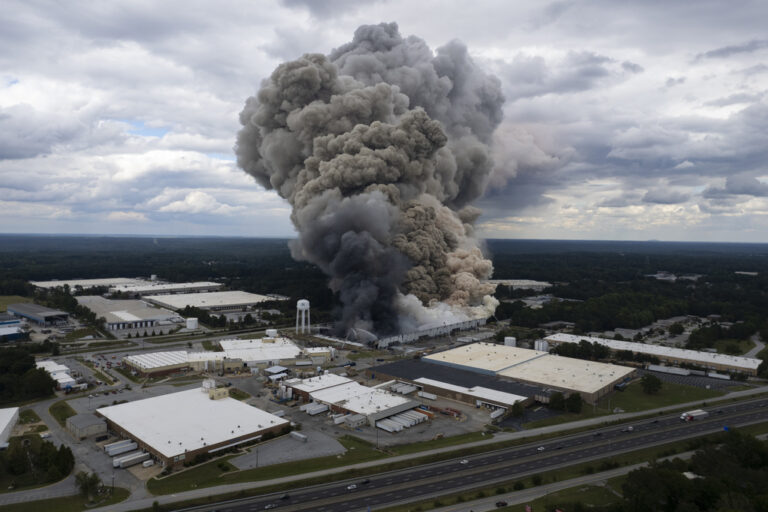Residents east of Atlanta were again warned Tuesday to take shelter where they are if shifting winds push the still-billowing chemical cloud from a chlorine factory fire over their neighborhood.
A shelter-in-place order had just ended Monday evening for Rockdale County, where the chemical fire sent a huge plume of orange and black smoke into the Georgia sky on Sunday. People complained about a strong chemical smell and haze for many miles around the BioLab plant in Conyers, about 25 miles (40 kilometers) southeast of downtown Atlanta.
“Due to the weather, the plume is banking down and moving throughout the county. If the cloud moves over your vicinity, please shelter in place until the cloud moves out,” Rockdale County officials told residents on social media early Tuesday.
The City of Atlanta said its firefighters continue to monitor the fallout, and urged anyone with “nose, throat or eye irritation, or difficulty breathing,” to call a Georgia Poison Center hotline.
“If you don’t have to be outside, if you don’t have to be on the roadways, stay home,” Rockdale County Board of Commissioners Chairman Oz Nesbitt said at a Tuesday morning news conference.
The fire was brought under control around 4 p.m. Sunday, officials said, but firefighters were still actively engaged Tuesday as the smoldering material kept sending up a plume of now grey-white smoke. The pollution “constantly shifted,” and with no strong prevailing wind to disperse it, smelly haze lingered across the Atlanta area.
BioLab’s website says it is the swimming pool and spa water care division of Lawrenceville, Georgia-based KIK Consumer Products. Residents around the area expressed frustration that company officials in their public statements didn’t specify what “products” were burning.
Atlanta’s fire department said it was testing for the presence of chemicals including chlorine, hydrogen sulfide and carbon monoxide. The U.S. Environmental Protection Agency also has been monitoring, for “chlorine and related compounds.”
Federal officials are investigating what led to the fire and how it has been handled. The sprinkler system showered water onto water-reactive chemicals around 5 a.m. Sunday, Rockdale County Fire Chief Marian McDaniel said. There were employees inside the plant, but no injuries were reported.
Residents north of Interstate 20 were ordered to evacuate on Sunday, while others were told to shelter in place. But residents of Atlanta’s densely populated eastern suburbs in DeKalb and Gwinnett counties also reported seeing a haze or the strong smell of chlorine.
Hours passed Sunday before DeKalb emergency management authorities said data suggested the air pollution was “unlikely to cause harm to most people.” The DeKalb statement said anyone concerned about breathing the chemicals could stay inside with their homes sealed up and air conditioners turned off.
An EPA statement said “the odor threshold for chlorine is very low, meaning people can smell it at very low concentrations that do not cause harm.”
Nesbitt made a point of holding the news conference outdoors Tuesday morning, to show that “it’s all right for us to stand out here.” But he said “this has happened too many times,” and promised to work with state and federal officials to determine what’s to be done about the plant, once the immediate crisis is resolved.
There have been other destructive fires at the Conyers complex, which opened in 1973.
In May 2004, multiple explosions in a warehouse led to a huge fire that prompted the evacuation of 300 people as a chlorine-laden cloud rolled through the area, The Associated Press reported, sending up a plume of green, gray and white smoke that stretched 10 miles (16 kilometers) long. At least nine people went to hospitals with complaints of burning eyes and lungs.
In June 2015, six Rockdale County firefighters were hurt in a fire at the complex, and another fire in 2016 prompted some voluntary evacuations near the plant, the Rockdale Citizen reported.
In September 2020, a chemical fire prompted authorities to shut down Interstate 20 during the morning rush hour. Biolab workers tried to isolate decomposing chemicals to prevent the catastrophe, but their forklifts were sliding on the wet floor amid the fumes, and firefighters were hindered by poorly stacked pallets of materials, the Chemical Safety and Hazard Investigation Board later determined. Nine firefighters were evaluated at hospitals after inhaling hazardous vapors.
(AP)











